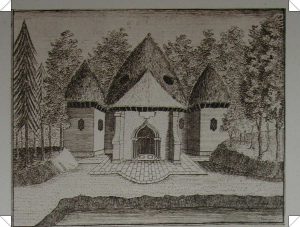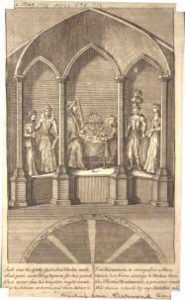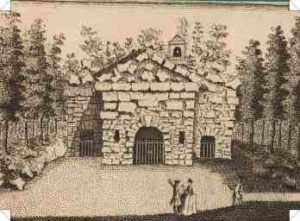Merlin’s Cave and The Hermitage – [Local History Notes: 6]
These were built in the gardens of Richmond Lodge by Queen Caroline (wife of George II) while she was resident there. The Queen took great interest in the gardens and delighted in adding such curious structures or ‘fancie’ as embellishments.
Both ‘fancies’ were designed by the Queen’s architect, William Kent. The Hermitage was started in November 1730 and was a semi-ruined grotto which enclosed an octagonal room and had a miniature bell-topped tower. It cost £1,114.
4 busts were placed inside the structure – thinkers who were admired by the Queen. George Vertue, an antiquary, wrote in 1731:
‘Four busts in stone are to be made by Signor Guelphi, a Sculptor, for the Queen’s [building] at Richmond: Sir Isaac Newton, Locke, Dr Clarke and Mr Woolaston [the last two are contemporary philosophers and theologians]. This Sig Guelphi works under the direction of Mr Kent at the house of Lord Burlington.’
Merlin’s Cave
Merlin’s Cave, built in 1735, had timber and plaster walls, a Gothic arched entrance and a thatched roof resembling a beehive flanked by two smaller buildings, also thatched.
The Gentleman’s Magazine announced in a June 1735 issue:
‘A subterranean building is by Her Majesty’s order carrying on in the Royal Gardens at Richmond which is to be called Merlin’s Cave adorned with Astronomical figures and characters.’
 In August, the magazine gave a list of the wax figures which were installed in the building:
In August, the magazine gave a list of the wax figures which were installed in the building:
‘The figures Her Majesty has ordered for Merlin’s cave were placed there, viz :
- Merlin at a table with conjuring books and mathematical instruments, taken from the head of Mr Ernest, page to the Prince of Wales.
- King Henry VIII’s Queen, and
- Queen Elizabeth who came to Merlin for knowledge, the former from the face of Mrs Margaret Purcell and the latter from Miss Paget’s.
- Minerva from Mrs Poyntz’s
- Merlin’s secretary from Mr Kemp’s one of His Royal Highness the Duke’s gardeners.
- A witch, from a tradesman’s wife at Richmond.
‘Her Majesty has ordered also a choice collection of English books to be placed therein; and appointed Mr Stephen Duck to be Cave and Library Keeper and his wife Necessary Woman there.’
Stephen Duck (1705-1756), was the self-educated thresher-poet from Wiltshire who worked in the gardens as a labourer and became a protégé of the Queen.
Pope and Swift
Although mocked by certain people, including Pope and Swift, the Cave proved a great success with the general public who were admitted to the gardens on certain days. The Craftesman, writing in the Gentleman’s Magazine, described the Hermitage:
 ‘ … as a heap of stones, thrown into a very artful disorder, and curiously embellished with moss and shrubs, to represent rude nature. But I was strangely surpris’d to find the entrance of it barr’d with a range of costly gilt rails, which not only seemed to show an absurdity of taste, but created in me a melancholy reflection that luxury had found its way even into the Hermit’s Cell.’
‘ … as a heap of stones, thrown into a very artful disorder, and curiously embellished with moss and shrubs, to represent rude nature. But I was strangely surpris’d to find the entrance of it barr’d with a range of costly gilt rails, which not only seemed to show an absurdity of taste, but created in me a melancholy reflection that luxury had found its way even into the Hermit’s Cell.’
His visit to Merlin’s Cave brought a similar response:
‘I observed something like an old haystack thatch’d over, and enquired of our conductor what it was. “That, Sir, is the Cave” said he. “What! a cave above ground? This is more absurd than the other. However let us see what is within.” We then went through a gloomy passage with two or three odd windows which led to a kind of circular room, supported with wooden pillars. In this, too, as well as in the Hermitage, are placed several hieroglyphical figures, male and female, which I cannot pretend to interpret.’
George II was also not impressed by his wife’s ideas – except for the cost. Lord Hervey, talking to the couple about the brass gates of the Henry VII chapel Westminster reported the following conversation. ‘The King stopped the conversation short by saying “My Lord, you are always putting some of these fine things in the Queen’s head, and then I am to be plagued with a thousand plans and workmen.” Then, turning to the Queen, he said, “I suppose I shall see a pair of these gates to Merlin’s Cave, to complete your nonsense there.” The Queen smiled and said Merlin’s Cave was complete already…”A propos,” said the Queen, “I hear the Craftsman has abused Merlin’s Cave.” “I am very glad of it,” interrupted the King; “you deserve to be abused for such childish, silly stuff, and it is the first time I ever knew the scoundrel in the right.” ‘
When Lancelot Brown (known as Capability Brown), the architect and garden designer, remodelled the gardens in about 1770, both The Hermitage and The Cave were demolished.
Further reading
Cloake, John / Palaces and Parks of Richmond and Kew. Volume II: Richmond Lodge and the Kew Palaces (1996)
Courlander, Kathleen / Richmond: from Kew Green to Ham Common (1953)
Nairn, Ian and Pevsner, Nikolaus / Surrey. (The Buildings of England; 2nd Rev. ed) (1983)
More information on other historic buildings in the London Borough of Richmond upon Thames is available from the Local Studies Library & Archive.
